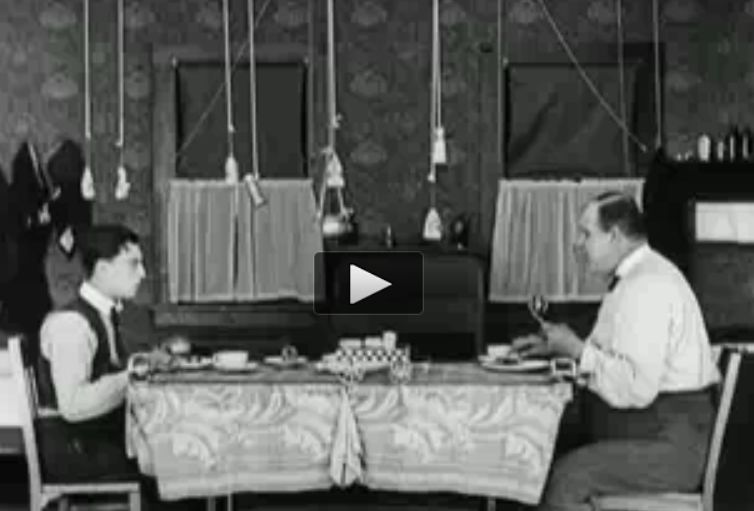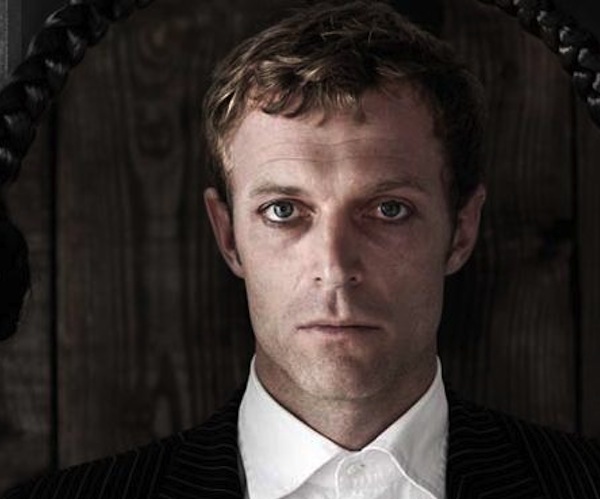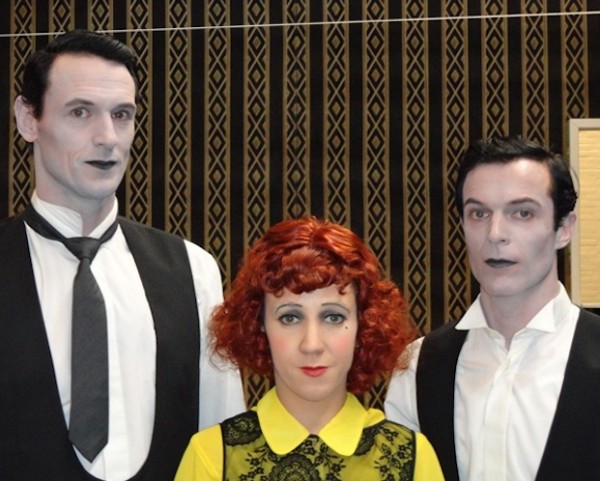Theater Interview: Silent Film Comedy Staged Live — Jakop Ahlbom Talks about “Lebensraum”
“Buster Keaton’s imagination and ideas are more surrealistic than Chaplin’s, and his stunts are astonishing in terms of their demanding technique, even today.”
By Bill Marx
It should be no surprise that New Vaudeville would be inspired by one of the greatest vaudevillians of them all — Buster Keaton, the comic genius of silent film. Few have summed up the brilliance of the world created by the clown nicknamed ‘The Great Stone Face’ better than the great film critic James Agee: “In a way, his pictures are like a transcendent juggling act in which it seems that the whole universe is in exquisite flying motion and the one point of repose is the juggler’s effortless, uninterested face.”
The paradox of Keaton’s deft physicality, generated by miraculously timed stunts, and the uncanny still point of his face fascinated the surrealists (Luis Buñuel among them) and continues to influence the unconventional slapstick of such contemporary performers as Bill Irwin and the Blue Man Group. Dutch-based director/choreographer Jakop Ahlbom is very much part of the post-modern Keaton fan club, and his critially acclaimed performance piece Lebensraum (Habitat) (presented by Arts Emerson at the Paramount Center Mainstage, April 9 through 13), owes much to the silent clown, with a particularly strong nod to his 1920 movie The Scarecrow. In that short film, two men live together in a room filled with handmade, time-saving gadgets. The breakfast table is arranged so that all the condiments and utensils can be shared by the guys without them having to move much: salt and pepper containers hang from strings on the ceiling; a bottle of milk is swung, via ropes and pulleys, out of the refrigerator and around the room.
In Lebensraum, Ahlbom emphasizes (or builds on) the dreamlike yet mechanistic nature of Keaton’s comic vision. He adds a fairy tale component in which the men invent an adult-sized female doll to help out around the house. Chaos, of course, ensues.
The challenges posed by following in Keaton’s footsteps in a live performance is considerable. The comedian could do multiple takes for film — there is no such luxury for Ahlbom’s cast. The timing must be perfect. The musical accompaniment for the surreal hijinks has been updated — indy rock group Alamo Racetrack will be onstage. I sent Ahlbom some questions, via e-mail, about his fascination with Keaton, the significance of the show’s title, and how seriously he is examining notions of gender.
Arts Fuse: Lebensraum is inspired by the silent comedy of Buster Keaton. Why Keaton instead of Chaplin or other great silent comedians?
Jakop Ahlbom: I love Chaplin, he is also great, but I feel more connected to Keaton because his comic persona is more melancholic, less emotionally expressive. Paradoxically, that means I can emotionally connect with him more, but it is through his physicality, his movements and stunts. His imagination and ideas are also more surrealistic and very astonishing in terms of their demanding technique, even today.
AF: What are the most difficult elements of Keaton’s comedy to duplicate on stage?
Ahlbom: His stunts: we rehearsed a lot and managed to be able to do most of them. But what as absolutely the most difficult thing to pull off was duplicate his timing, which is an essential part of his comedy. At first, we tried to recreate a lot of different gags in the spirit of Keaton. But they didn’t work because we where trying to hard to make something funny. I went back to look at Keaton’s films, to if I could figure out what it is that he does. And then I think I got it. Instead of trying to make it funny we did the opposite — we took everything seriously and made the stunts more dramatic. And then, suddenly, the comedy started to work.
AF: A challenge when working with silent film comedy today is to go beyond making due with nostalgia and cutesiness — how did you avoid that?
Ahlbom: That’s why I didn’t want to recreate a love triangle, which is mostly the narrative structure that propels Keaton’s short films. And we didn’t want to copy the piano-music which was used then to accompany Keaton’s movies. Most of the music we use here is on the guitar, and the musicians play live onstage. They are very much part of the performance. The performers’s actions are also direct and physical; they avoid creating a sweet, sentimental atmosphere by being dramatic and emotional in their movements.
AF: It is interesting that a woman plays a major role in Lebensraum — Keaton usually related them to secondary characters, the love interest, etc.
Ahlbom: This is one of the dramatic ideas that generated the context of the performance.
In this piece I wanted to deal with the power of nostalgia at the time when sound came in and ended the era of silent film. I wanted to emphasize the challenged posed by ‘change.’ The men’s creation of a woman is rooted in a deep need for change, but are they ready for it? The woman they invent is colorful and eccentric: she changes the males’ way of life. So the female becomes a powerful part of the performance, a magnetism that is emphasized by remarkable way in which Silke Hundertmark plays the doll.
AF: A Dutch critic wrote that Lebensraum was a “surrealistic fairy tale” — Would you agree that this piece has some connections with the monster-making in Frankenstein?
Ahlbom: Yes I agree, but in the process of creating this piece we had Pinocchio in mind.
AF: Please talk about the significance of the title — Lebensraum is German for “living space,” a basic principle of Nazi foreign policy.
Ahlbom: I didn’t know that this connection was so strong. Of course, people told me that when I was looking for a title, actually a good friend came up with it. Most of my titles are in German. I see the men’s space as a habitat, but the word ‘habitat’ a the titles was too abstract for me. There is a furniture store called that. “Lebensraum’ is more poetic. In Germany, it is still used today and it has nothing to do with Nazi Germany. it is a term used when talking about the living space around animals. Maybe with this show I can clean the word of its negative connotation.
AF: In this piece, men create a female robot. Are you making a serious statement about gender politics?
Ahlbom: When I create a performance piece I try to imagine a situation which generates feelings in the audience. I’m not really trying to make a hard statement. Every individual in the audience will have a different experience with the performance, so each audience member will see something different. And that is all right by me.
Of course, I’m aware of all the interpretative possibilities when I make a piece, and I make clear decisions for myself. But I don’t want to explain them to the audience. I want viewers to figure things out for themselves. I want to touch people first through the heart and then the brain, rather than the reverse. I will say that in my performance pieces I am critical of the sometimes one-dimensional perspective of male thinking.
AF: How is the music in the production used? Does Alamo Race Track accompany the action? Comment on it? Shape audience reaction?
Ahlbom: The musicians are part of the staging to the point of being characters that are very much a part of the action. Alamo Race Track helps shape the performance.
Bill Marx is the Editor-in-Chief of The Arts Fuse. For over three decades, he has written about arts and culture for print, broadcast, and online. He has regularly reviewed theater for National Public Radio Station WBUR and The Boston Globe. He created and edited WBUR Online Arts, a cultural webzine that in 2004 won an Online Journalism Award for Specialty Journalism. In 2007 he created The Arts Fuse, an online magazine dedicated to covering arts and culture in Boston and throughout New England.



